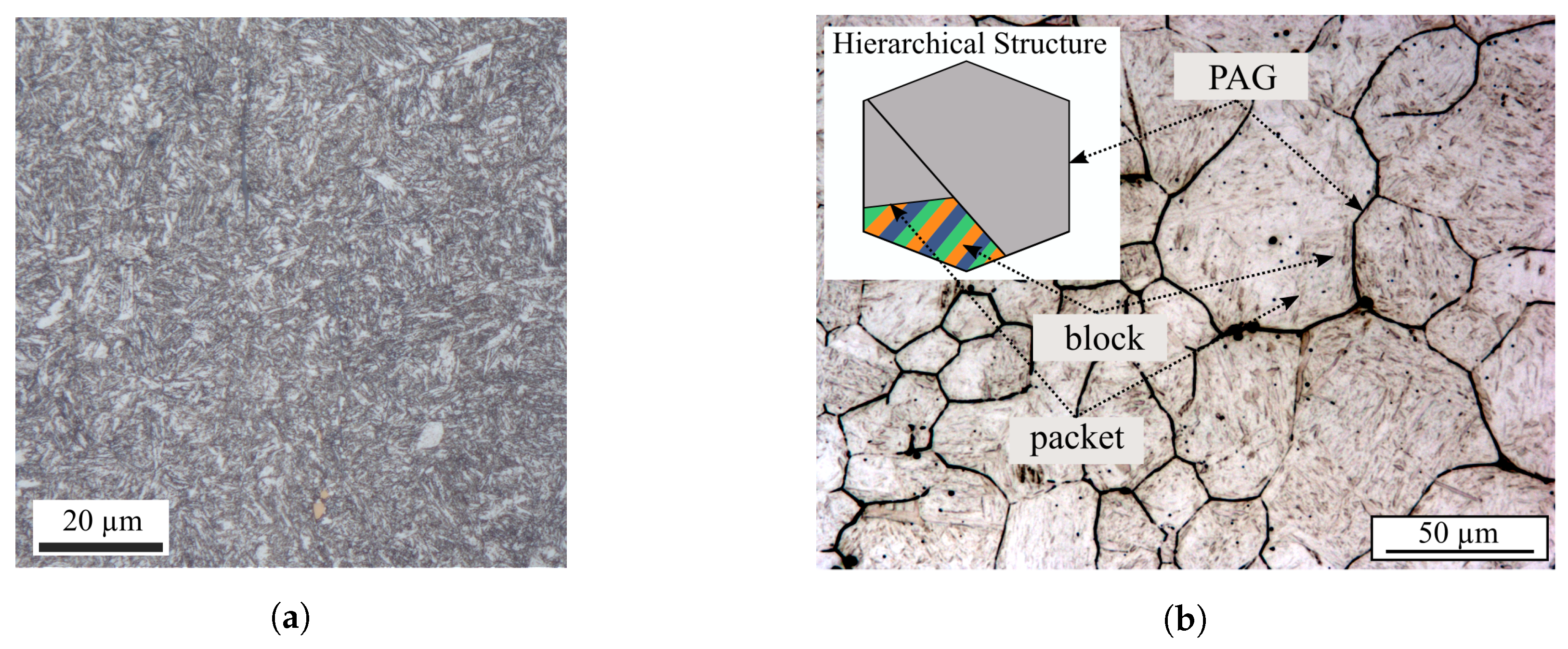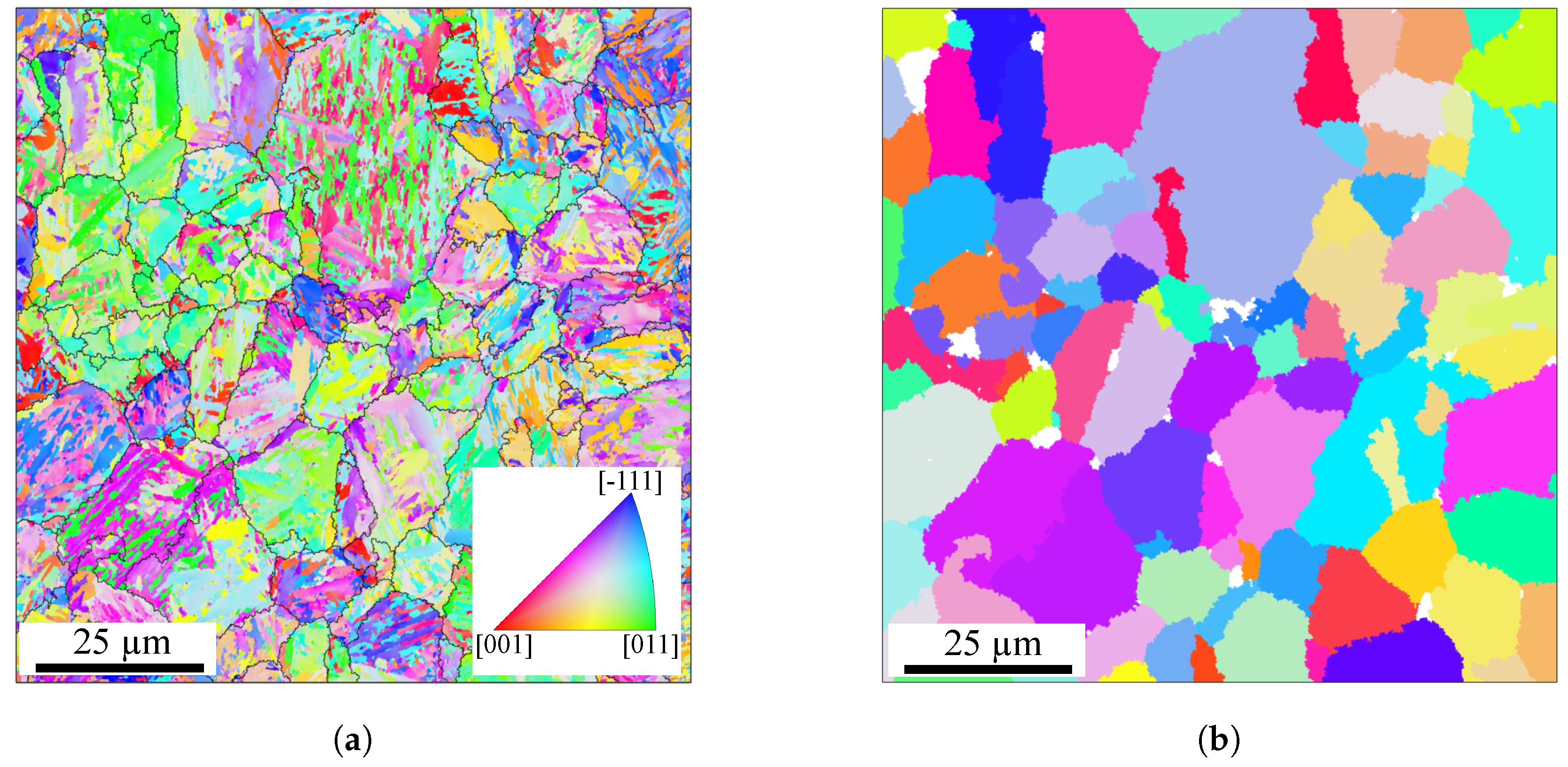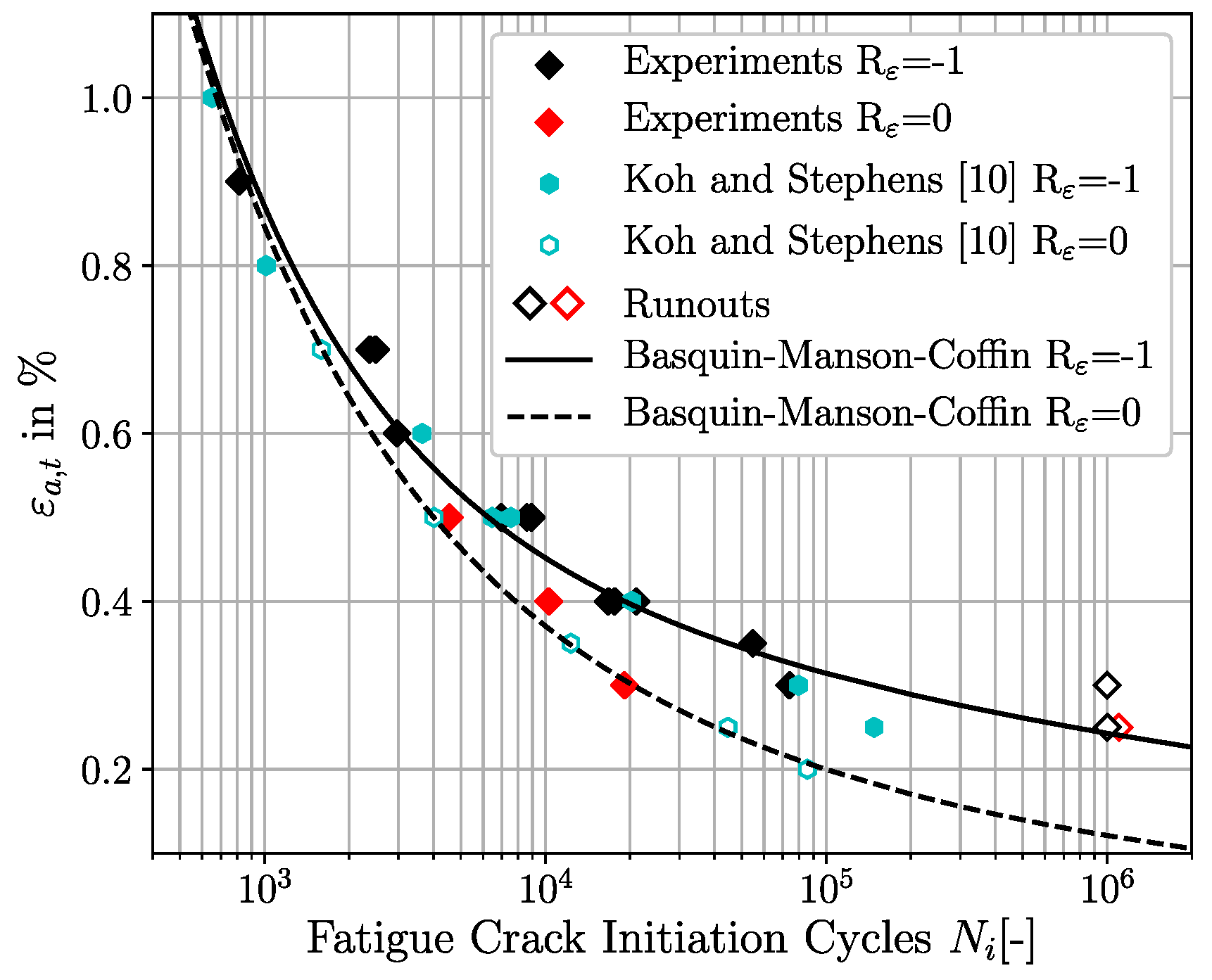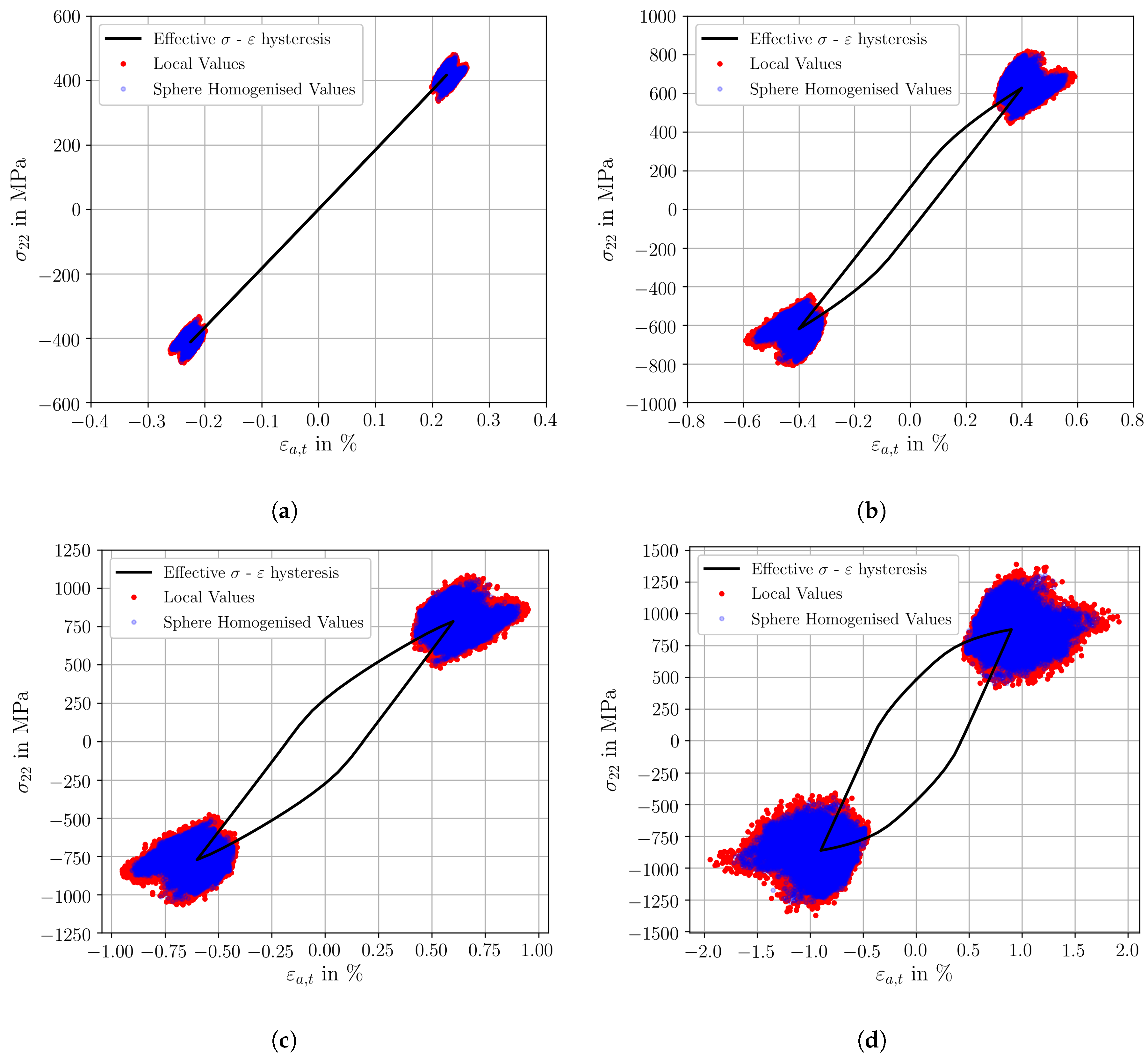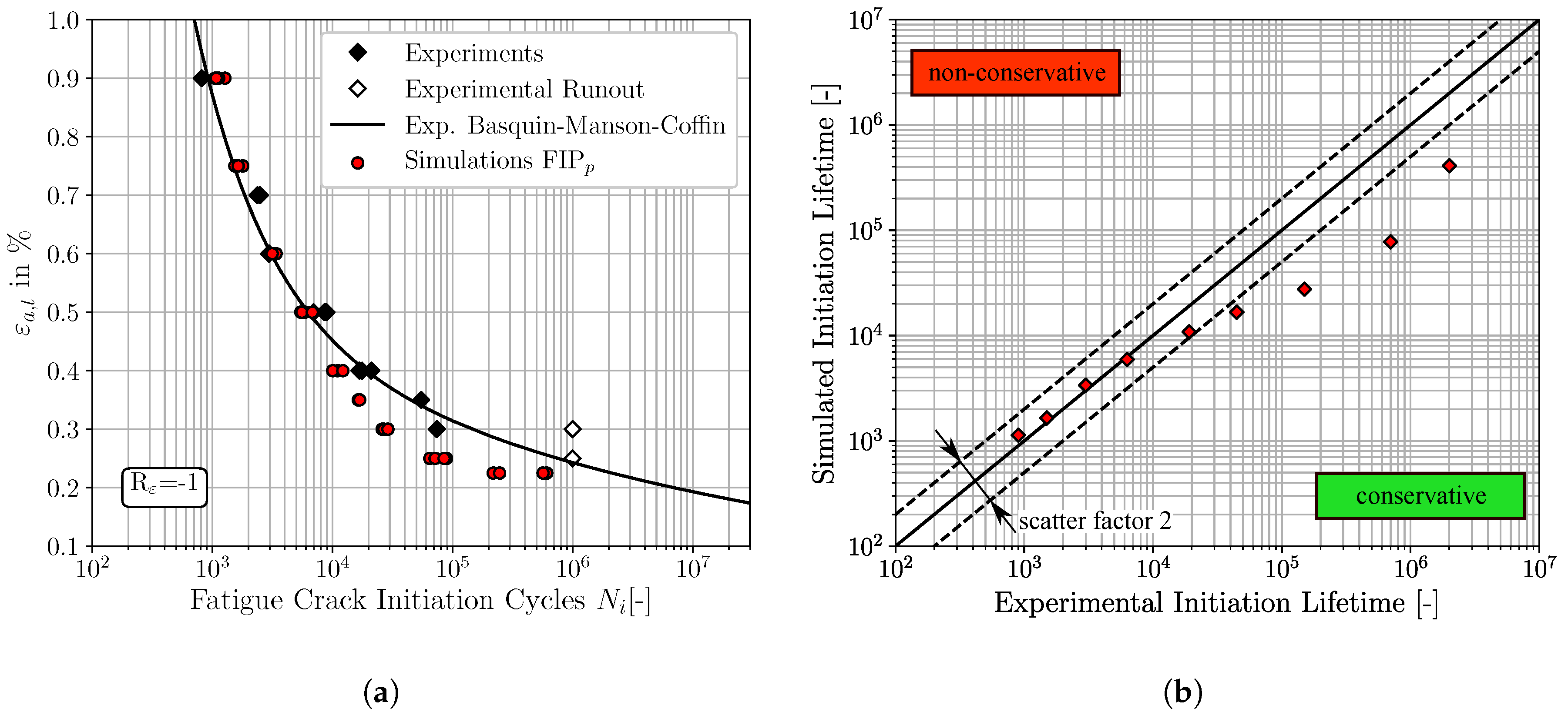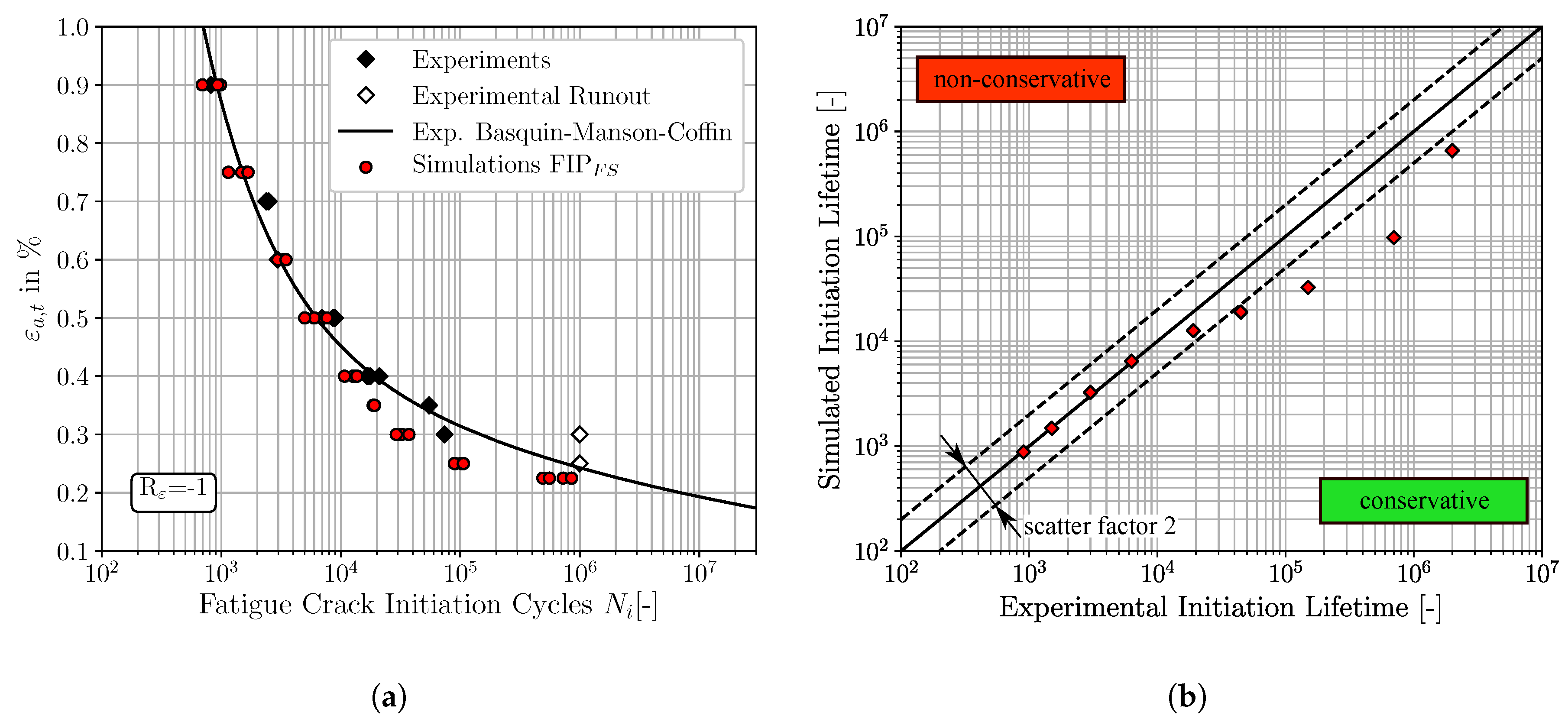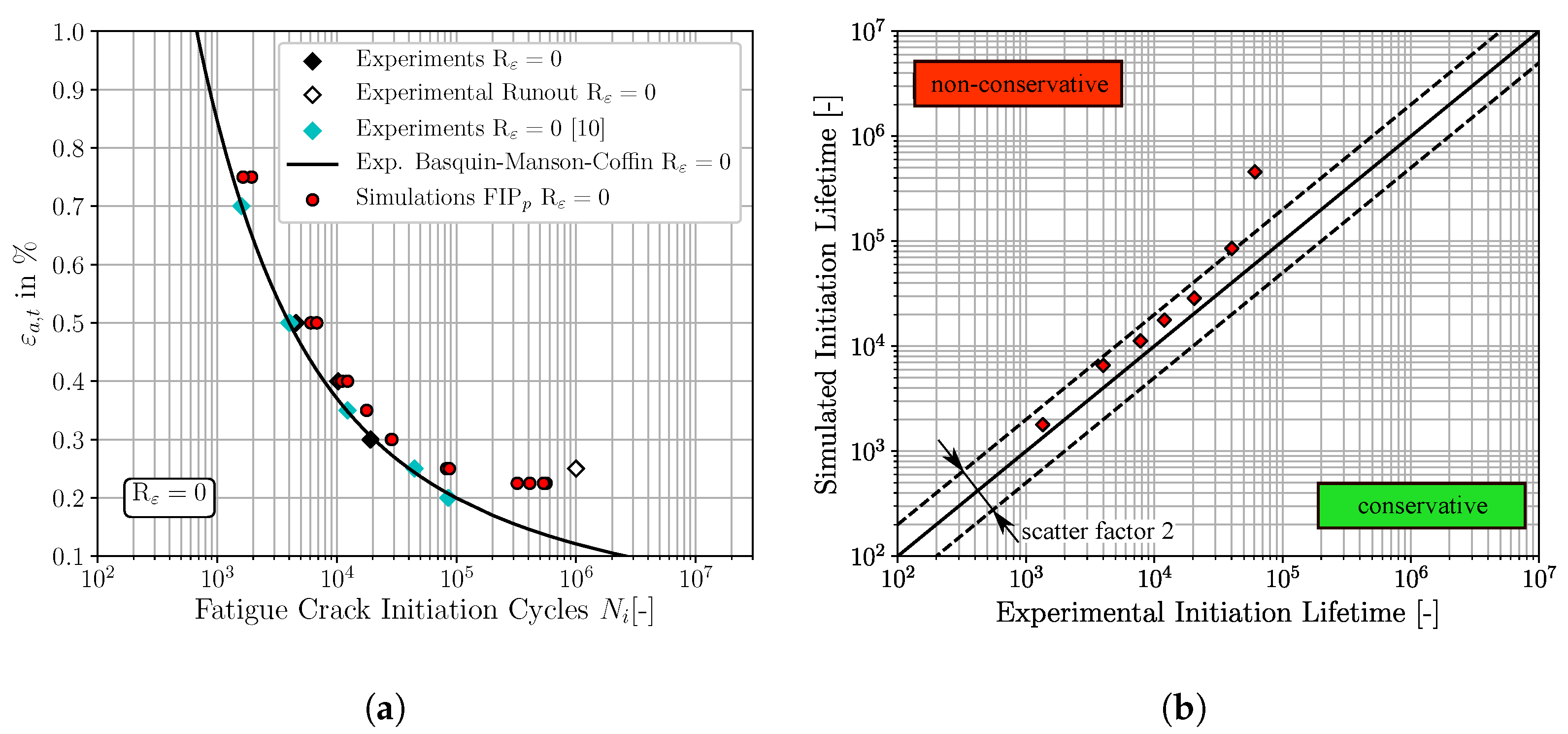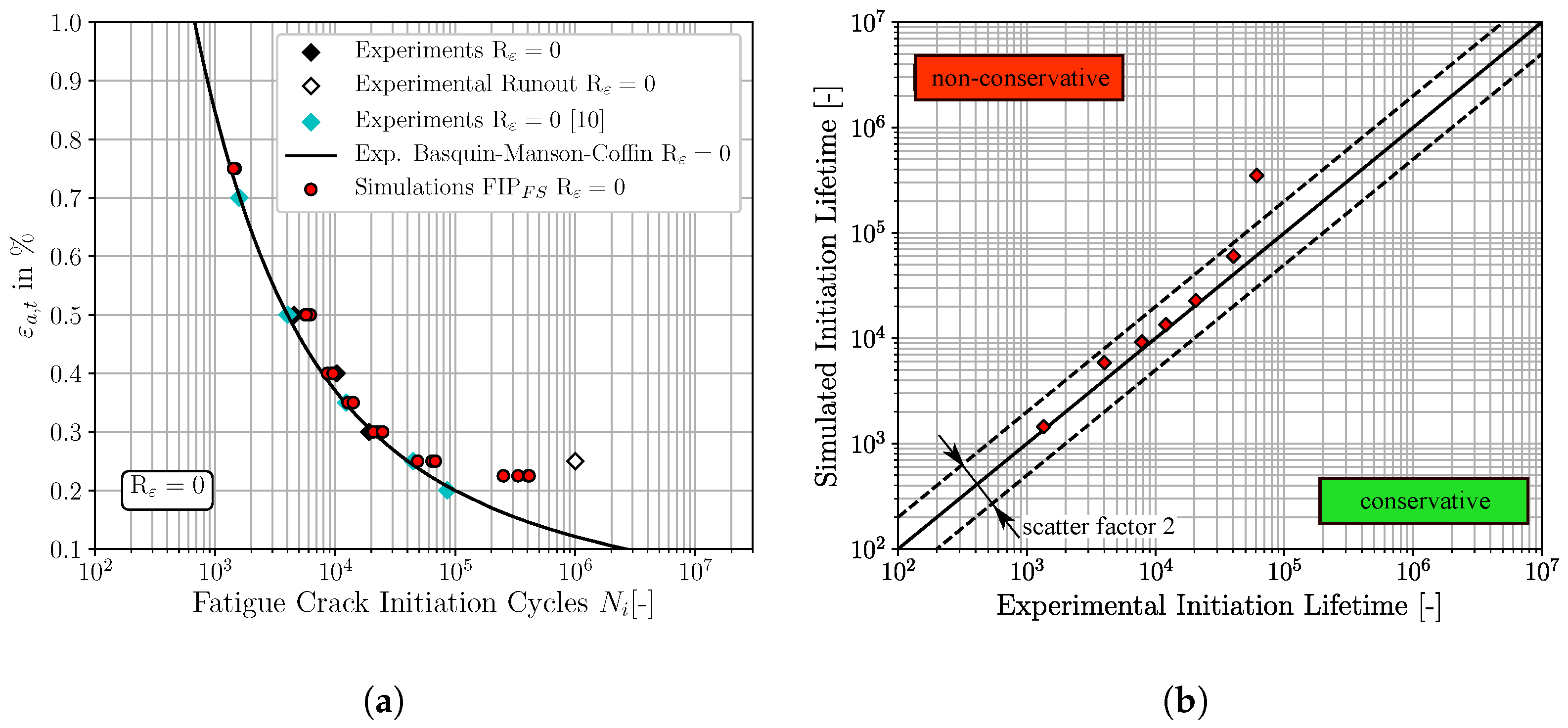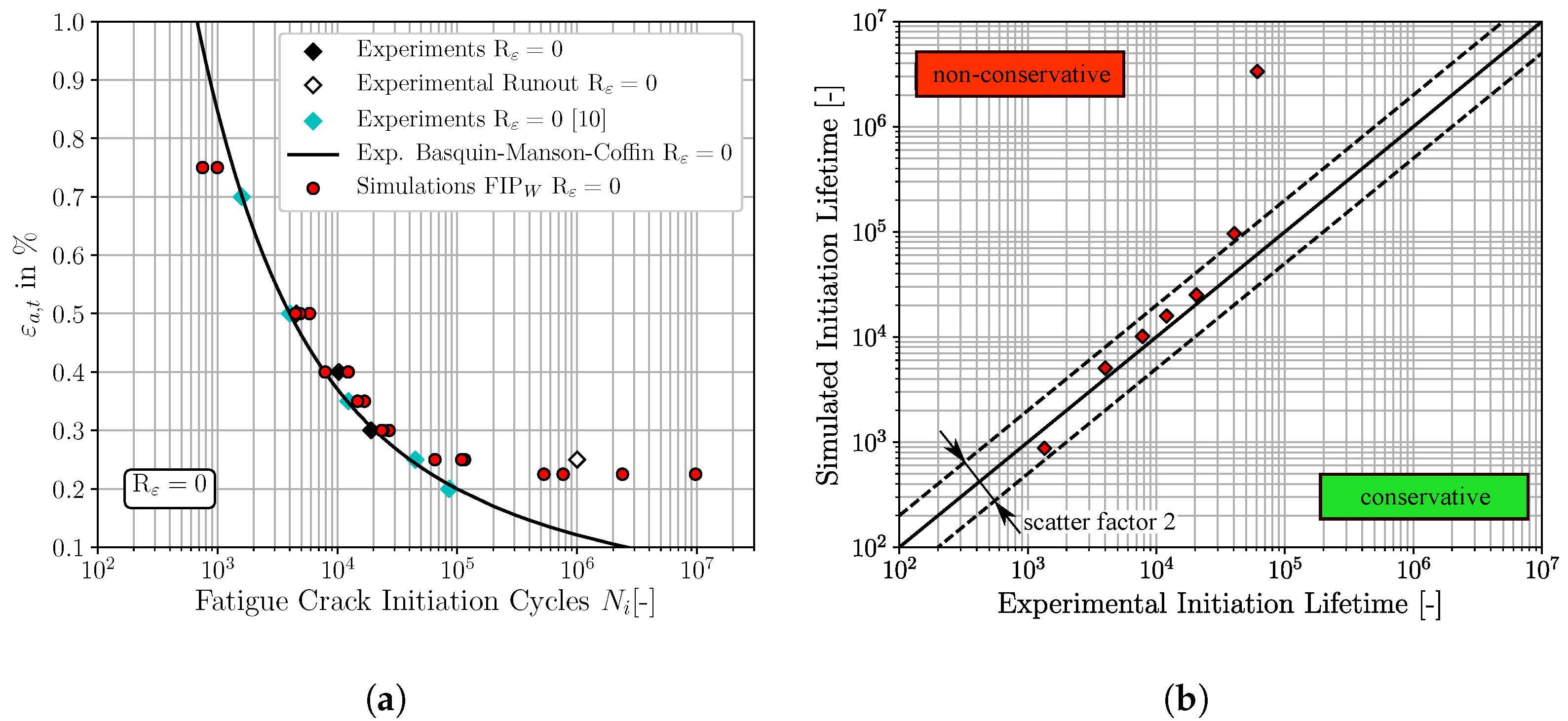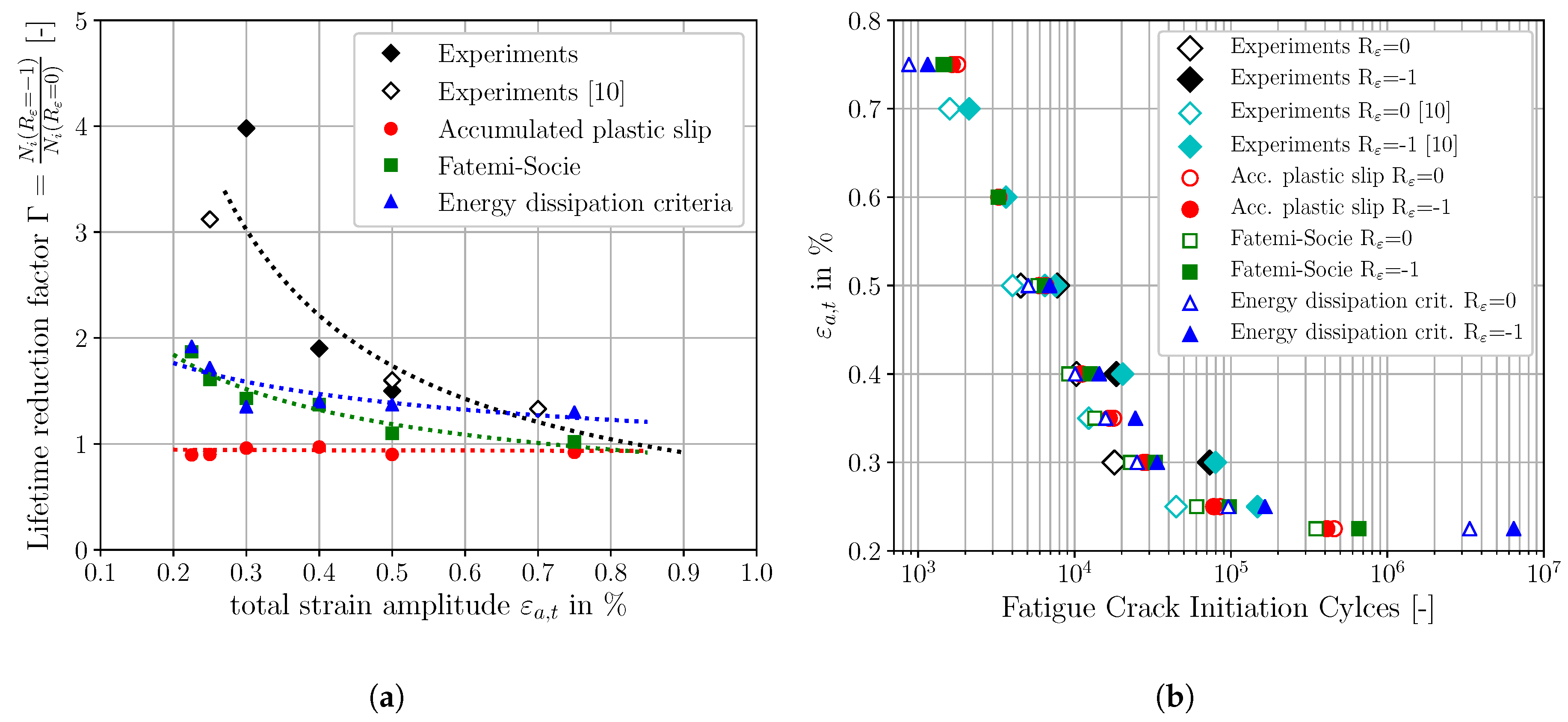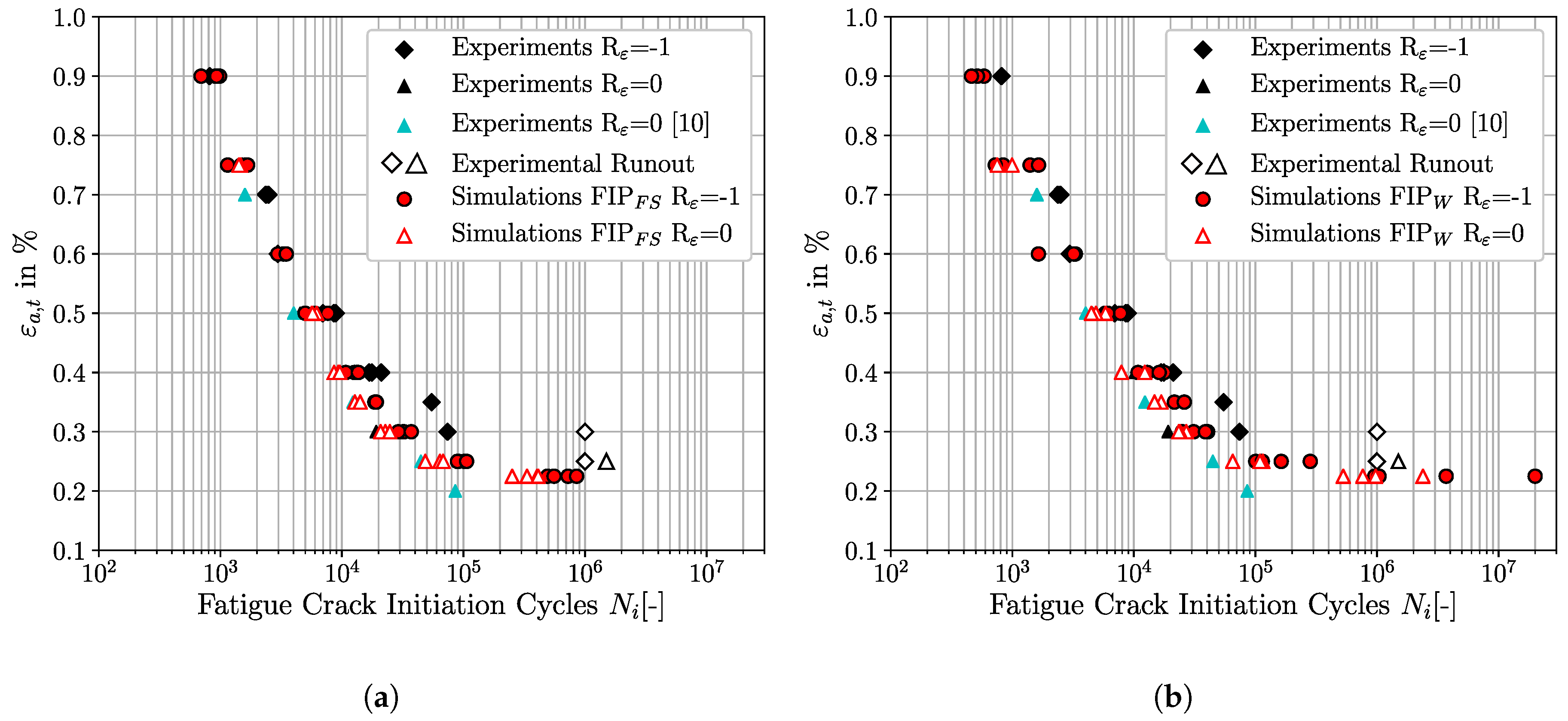1. Introduction
Martensitic high-strength steels are distinguished by a high strength to weight ratio, an excellent weight and cost-effectiveness as well as a more environmental friendly energy balance than aluminium alloys. These attributes are of particular importance in today’s challenges such as the design of sustainable transportation systems [
1]. Among these martensitic high-strength steels, the quenched and tempered SAE 4150 plays a pivotal role due to its excellent strength and toughness. These specific material properties are directly related to the unique hierarchical martensitic microstructure being an assembly of of laths, blocks and packets [
2,
3]. Despite these remarkable material properties, the components produced from this class of material are prone to a high risk of fatigue failure during service life. A fundamental prerequisite for the prediction of components fatigue life is the adequate modelling of the influence of varying load ratios on the cyclic fatigue behaviour due to the lifetime reducing effects of positive mean stresses and strains [
4]. Future advanced fatigue life estimation tools should, therefore, predict mean stress effects on fatigue life precisely.
Experimental investigations on low and medium carbon-alloyed martensitic high-strength steels have been focused on several fields of research, in the last decades. Fundamental investigations on the morphology and crystallography enabled a profound understanding of the hierarchical architecture of lath martensite. During the diffusionless, shear-dominated transformation from austenite (
phase) to martensite (
phase), 12 up to 24 crystallographic variants can be formed from a single prior austenite grain (PAG) with the Nishiyama–Wassermann and Kurdjumov–Sachs orientation relationship, respectively [
2,
3,
5]. The deformation behaviour of lath martensite structures was extensively studied e.g., by Mine et al. [
6], Du et al. [
7] and Shibata et al. [
8] with respect to the effectiveness of grain boundaries within the hierarchical morphology of martensite. Accordingly, block and packet boundaries represent effective barriers for dislocation motion and plastic deformation transfer, respectively. The effects of mean stresses on fatigue life have been long studied, as for example in the early fundamental works of Gerber and Goodman, cited in Shijve [
9]. Mean stress and mean strain effects become relevant and reduce fatigue life for elastic bulk material response as it is in the high cycle fatigue (HCF) regime [
4]. An increase of the mean stress or mean strain (at constant stress or strain amplitude) yields to an increase of the maximum stress level and consequently to an increase of the driving forces for fatigue crack initiation (FCI) and growth [
9]. In contrast, in the low cycle fatigue (LCF) regime of strain-controlled fatigue experiments with elasto-plastic material response, increased mean strain levels cause mean stress relaxation in early life. Consequently, the LCF life will not be appreciably affected by the superimposed mean strains in contrast to fully reversed tests [
4]. In the past, a variety of martensitic high-strength steels were subject of experimental investigations about the influence of mean strains on the total fatigue life. Koh and Stephens [
10] and Wehner and Fatemi [
11] investigated comparable quenched and tempered medium carbon-alloyed steels and showed the detrimental effect of tensile mean strains on fatigue life for small applied total strain amplitudes in the HCF regime. However, there are only few consistent fatigue crack initiation data sets for the considered material at total strain-controlled conditions in literature available. Therefore, new fatigue tests were performed in this study.
The total fatigue life of polycrystalline materials can be decomposed into two fundamental stages of fatigue represented by macroscopic fatigue crack initiation and macroscopic fatigue crack propagation [
12,
13,
14,
15]. From a microscopic point of view, the macroscopic fatigue crack initiation stage can be further subdivided into the stages of fatigue crack nucleation, microstructurally short crack (MSC) growth and physically short crack (PSC) growth [
12,
16]. The nucleation period represents an early stage of fatigue life [
17]. Thereby, localisation and accumulation of irreversible plastic slip are one of the primary driving forces for fatigue crack nucleation [
13]. Both fatigue crack nucleation and micostructurally short crack growth are directly influenced by the local microstructural attributes, such as grain size and orientations, and reveals consequently a significant microstructural dependency [
13,
16]. Depending on the strength and the loading conditions of steels, the FCI life (nucleation life + microstructurally short crack life) may account for the majority of the total fatigue life, in particular in the HCF regime [
14,
18,
19,
20]. Due to the enormous experimental effort on FCI investigations on martensitic steels, they have received less attention than studies on crack propagation. In order to overcome this, micromechanical modelling techniques incorporating representative volume elements (RVE) and crystal plasticity models on the crystal scale provide powerful techniques to investigate the fatigue phenomena mechanisms in detail [
16,
21,
22,
23].
For the micromechanical prediction of fatigue crack nucleation, the local mechanical fields are used to determine mesoscopic FIPs representing driving forces for fatigue crack initiation and growth [
16]. There are a variety of different FIPs correlating different micromechanical quantities to these surrogate measures for fatigue, e.g., the shear based accumulated plastic slip, the multiaxial fatigue criteria proposed by Fatemi and Socie [
24] and different energy based criteria. Manonukul and Dunne [
25] investigated the LCF and HCF life of a nickel alloy C263 by correlating the accumulated plastic slip with the cycles required for FCI. Based on the Tanaka-Mura model, Brückner-Foit and Huang [
26] studied the heterogeneous stress distributions with an elasto-plastic orthotropic material model and predicted the crack densities in the LCF life of a martensitic steel with a good agreement to experimental results. Using an energy dissipation criteria, Cruzado et al. [
22] predicted the FCI cycles for IN718 alloy for different strain ratios. The reported results were in good agreement with experimental results for both strain ratios, therefore it is assumed that the energy dissipation criteria is well suited for predictions of FCI results at different strain ratios. A comparison of the accumulated plastic strain and an energy dissipation criteria was performed by Sweeney et al. [
23] for a CoCr stent material for one loading level. The corresponding results indicated, that the energy dissipation criteria shows a higher sensitivity to local stress variations than the accumulated plastic slip. A lath martensitic microstructure under fully reversed fatigue loading was also investigated micromechanically by using a shear based critical plane FIP and the Tanaka-Mura model by Briffod et al. [
27]. Gillner and Münstermann [
28] developed a micromechanically informed extreme value distribution density based fatigue model for the prediction of HCF life. The grain averaged accumulated plastic slip is used for the calculation of the fatigue crack nucleation life. The stages of MSC, PSC and long crack regime are modelled by an extreme value distribution density approach which has to be calibrated by experimental HCF data. The stress-controlled model shows a good agreement with experimental results for different stress ratios. However, in addition to the LCF experiments for the calibration of the crystal plasticity model, further HCF experiments are required to calibrate the extreme value distribution density approach for the propagation regime. Recently, Chen et al. [
29] compared experimentally observed fatigue crack nucleation sites with predicted nucleation sites by the accumulated plastic slip, the Fatemi-Socie metric, an energy dissipation criteria and a stored energy density criterion for a nickel alloy under reversed loading conditions. They concluded, that the local stored energy density metric incorporating the density of geometrically necessary dislocations reveals the best agreement to the experimentally observed nucleation sites. However, this localisation metric requires the application of a non-local crystal plasticity model for the calculation of the geometrically necessary dislocations. There have been numerous further investigations on FCI predictions by different FIPs. However, a comparison of different types of FIPs for martensitic high-strength steels under different loading conditions is still missing in the available literature.
The purpose of the present study is the micromechanical prediction of fatigue crack initiation life for the martensitic high-strength steel SAE 4150 for two different applied total strain ratios, R and R, whereby the total strain ratio R is defined by the ratio of the minimum applied total strain and the maximum applied total strain during a cycle. For this purpose, a comparison of three selected different FIPs, accumulated plastic slip, Fatemi-Socie and an energy dissipation criteria, concerning their applicability at varying loading conditions is presented in the present study.
The paper is structured as follows: first, in
Section 2 the martensitic high-strength steel SAE 4150 is characterised with respect to microstructural properties as well as to experimental LCF and HCF behaviour. Next, the multi-scale modelling strategy incorporating the generation of synthetic microstructures, the constitutive model and the different fatigue indicator parameters are presented in
Section 3. Results of the micromechanical fatigue investigations are presented and discussed in
Section 4. Finally, the main conclusions are summarised in
Section 5.
